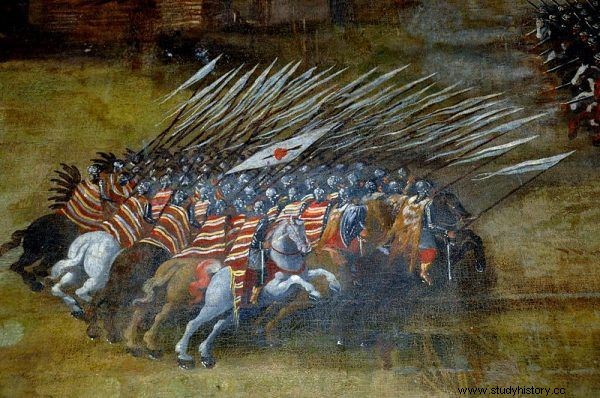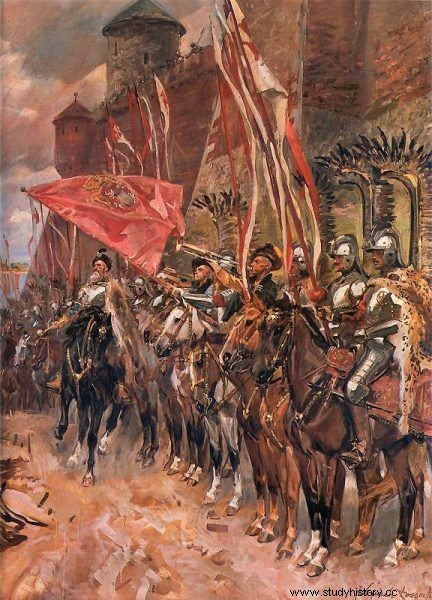The most popular Polish armed formation still hides many secrets. Get to know the most interesting facts related to the history of the famous hussars.
In a few cases, the armor saved the lives of the hussars wearing them, although they were hit by cannonballs. This was the case, for example, on August 30, 1633, in the battle of Smolensk, or on September 26, 1660, in the battle between Lubar and Cudnów.
***
In the battle of Kluszyn many hussar rots charged the enemy even 10 times.
***
The largest number of hussars in history took part in the battle of Chocim in 1621. There were 8,520 of them in 53 rotors full-time. However, taking into account the so-called blind portions, it can be assumed that there were less than 8 thousand there
***
Hussars are not only regular military, state or private. When a common noble movement was gathering, its members also equipped themselves as lighter cavalry or hussar-like . For example, in 1665, the Greater Poland mass mobilization stood in the strength of 3.9 thousand. horses, of which 1.4 thous. in hussar.
***
The longest hussar lances reached 6.2 m.
Among the hussars there were strongmen who picked up three ten-digit copies at a time with one hand (10 cubits is almost 6 meters). Another trick was shown by the hussar Zygmunt Kazanowski, who later became the tutor of prince Władysław Waza. Standing on a sharp point, he turned on it several times without harming his body.
***
In the battle of Połonka on June 28, 1660, a single blow with a hussar lance pierced six Moscow infantrymen at once.

Hussars in the battle of Kłuszyn
***
It happened that the hussars descended from their horses and attacked the enemy on foot. For example, on September 8, 1581, as many as 1,500 hussars in armor, with lances, muskets or pistols, took part in the storming of the walls of Pskov.
Jaruzelski, Kaczyński, Komorowski, Duda. What do these names have in common? Apart from the fact that these are the names of the presidents of Poland after 1989, people with these surnames served in the hussars . For example, Duda, being a musician in the Hussar banner (he played bagpipes, of course), took part in the aforementioned storming into the walls of Pskov.
In 1683 Wacław Jaruzelski was a companion in the hussar banner of Stefan Mikołaj Branicki, which fought in the Battle of Vienna. In 1690, he became its lieutenant, which he was until the end of 1705. In the years 1702–1705 he even called himself a hussar colonel. His son, Franciszek Jaruzelski, in 1706 became the standard-bearer of this Hussar rota, and in 1710 he was promoted to its lieutenant. At that time it was the rota of Jan Branicki, because his father Stefan Mikołaj was already dead.

The Hussars are the most famous Polish armed formation
Samuel Komorowski, as a lieutenant in the Hussar banner of the Lithuanian field hetman, Janusz Radziwiłł, became famous in the battle of Łojów in 1649 (see chapter Universal Knight). Kaczyński, as a companion of the light hussars, stormed the walls of Smolensk on August 21, 1610. However, he was not lucky. The assault was unsuccessful and he himself was shot.
***
The hussars defeated even a dozen or so times larger enemy. For example, on September 7, 1621, around 600 hussars spent around 10,000 from the field near Khotyn. Ottoman soldiers. In turn, on September 26, 1660, around 140 hussars smashed at least 1,700 Cossacks and Muscovites near Kutyszcz.
***
In the Battle of Vienna on September 12, 1683, the allied Imperial-German cavalry stopped their horses to be able to admire the hussars beginning their charge.
Hussars sometimes painted their horses "ford", which can be seen on the Stockholm Roll. To dye horses red, for example, a broth of brasilia with alum was used. Horses were painted not only at ceremonies, but also during military operations.
***
One of the most respected leaders in the history of mankind, the Swedish king Gustav Adolf, said about the hussars:“Oh, if I had such a ride; I would camp with my foot in Constantinople this year.
He was so admired by the sight of the hussars who, carried by their combat zeal, were jumping from a steep hill down like a precipice . All this to strike the Swedish infantry, which, protecting themselves from the hussars' charge, left the ramparts on the hill and descended to its foot, hoping that the steep embankment would prevent Polish cavalrymen from reaching them. It happened on October 1, 1626, in the battle of Gniew.
“Good-bye, my service” - this is the phrase greeted by the Polish knights at the turn of the 16th and 17th centuries. These were the words:"I am grace, I am grace [aszmość] P [ana] Goodrod [zieja] and I give myself to a good heart."

The article is an excerpt from the latest book by Radosław Sikora Not only hussars which has just been released on the market
The attitudes and gestures were no less important than the words. When the nobles were equal in the social hierarchy, they bowed to each other just as low. With a more intimate acquaintance, they hugged and kissed each other on the shoulders . But when one person stood lower in the hierarchy, bent down or even fell to the feet of a taller person, kissed the feet, took them under the knees, or at least made a gesture of humility, while saying the phrase "I fall to my feet".
Compared to other European countries, women enjoyed a particularly high position in the Republic of Poland . The ethos of nobility demanded that they be treated with respect and gallantry. They were greeted, like priests of fiefs, by kissing the hand.
***
The Polish nobility, including the hussars who came from them, rejected the idea of awarding and wearing orders for a long time. In her opinion, it violated noble equality . She became convinced of this only in the 18th century. Therefore, the first order (the Order of the White Eagle) was established in Poland only in 1705.
***
At the funeral of a hussar comrade his copy was crushed . A horse hussar was rushing into the church, then, hitting the lance in front of the catafalque, he broke it, and himself, as if out of grief for the deceased, fell from his horse to the floor.
